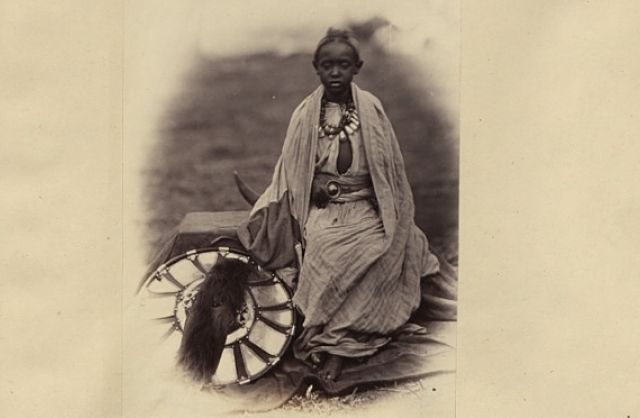 Seven-year-old Prince Alemayehu was captured – along with many national treasures – in 1868. His remains are held in Windsor Castle but pleas for their return have been rebuffed. (Photo: Northwestern University)
Seven-year-old Prince Alemayehu was captured – along with many national treasures – in 1868. His remains are held in Windsor Castle but pleas for their return have been rebuffed. (Photo: Northwestern University)
By Maaza Mengiste
This Ethiopian Prince Was Kidnapped by Britain – Now it Must Release Him
You see him first as he was soon after his father’s death: a seven-year-old boy staring, stunned, into the camera. He sits on a cloth-covered bench, next to a shield and a strip of animal hide. Around his shoulders, a long shamma drapes and gathers at his folded ankles. You note his bare feet, the way one toe, curled upward and tense, hints at the emotions he is keeping guarded. He wears the silver-baubled necklace that will travel with him from Ethiopia to England, the one also seen in pictures where he is made to sit for Julia Margaret Cameron and other photographers. His mother, if still alive, will soon die unexpectedly, leaving him in the hands of the same British men who came to confront his father. But for now, he has not lost everything.
This photograph of Prince Alemayehu was taken during the 1868 Napier expedition, a British military incursion into Maqdala, Ethiopia, to rescue three dozen European prisoners. His father, Emperor Tewodros, took captives when his letters to Queen Victoria were ignored. Led by Sir Robert Napier, the punitive mission was extravagant: 13,000 soldiers, 8,000 auxiliary workers, and thousands of followers in search of adventure or a story. Several, like Richard Holmes of the British Museum, also came in search of loot.
In the end, Emperor Tewodros released the prisoners unharmed, then committed suicide rather than surrender. What happened next would be described as a “deluge of fire” and one of the greatest looting orgies ever undertaken in the name of the British empire. Alemayehu, by now an orphan, was put on board the Feroze, the same ship as Holmes, who was taking back to Britain the largest haul of stolen artefacts in Ethiopia’s history. The objects went into British museums and libraries. Alemayehu became a ward of Queen Victoria and, despite his continual pleas to be returned to his homeland, he died aged 18 in England. He was buried at Windsor Castle, where he remains. A plaque, “When I was a stranger, ye took me in,” marks his vault.
Today, we can recognise Napier and his forces for the marauders that they were. We can acknowledge the imperialist arrogance that would kidnap a young boy and trumpet the achievement through newspapers and photographs. The generosity of hindsight might even explain why Alemayehu’s pleas to return home were refused. But there is no longer any excuse for that same refusal and arrogance. There is no viable reason to continue to hold his remains hostage. He has become, like the sacred and valuable objects still in British museums and libraries, a possession.
—
Related:
Photo of Prince Alemayehu Among Astonishing Portraits Unseen for 120 Years
Interview with Selam Bekele: Her Short Film on Exiled Life and Death of Prince Alemayehu Tewodros
Join the conversation on Twitter and Facebook.

























